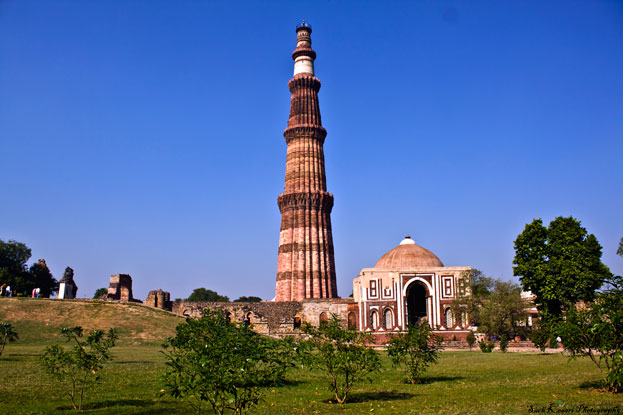Qutb Minar was built in the early 13th century a few kilometres south of Delhi; the red sandstone tower of Qutb Minar is 72.5 m high, tapering from 2.75 m in diameter at its peak to 14.32 m at its base, and alternating angular and rounded flutings. The surrounding archaeological area contains funerary buildings, notably the magnificent Alai-Darwaza Gate, the masterpiece of Indo-Muslim art (built in 1311), and two mosques, including the Quwwatu'l-Islam, the oldest in northern India, built of materials reused from some 20 Brahman temples.
Continent: Asia
Country: India
Category: Cultural
Criterion: (IV)
Date of Inscription: 1993
The Qutb Complex
Lalkot is the first of the seven cities of Delhi, established by the Tomar Rajput ruler, Anang Pal, in 1060. The Qutb complex lies in the middle of the eastern part of Lalkot. Building of the Quwwatu'l-Islam (Might of Islam) congregational mosque was begun in 1192 by Qutbu'd-Din Aibak and completed in 1198, using the demolished remains of Hindu temples. It was enlarged by Iltutmish (1211-36) and again by Alauld-Din Khalji (1296-1316).
The Qutb Minar was also begun by Qutbu'd-Din Aibak, in around 1202 and completed by his successor, Muhammad-bin-Sam. It was damaged by lightning in 1326 and again in 1368, and was repaired by the rulers of the day, Muhammad-bin-Tughluq (1325-51) and Firuz Shah Tughluq (1351-88). In 1503 Sikandar Lodi carried out some restoration and enlargement of the upper storeys. The iron pillar in the mosque compound was brought from elsewhere in India.
 |
| Qutb Minar |
Browse Gallery Plus UNESCO Storyline
It bears a Sanskrit inscription from the 4th century AD describing the exploits of a ruler named Chandra, believed to be the Gupta King Chandragupta II (375-413). Of the other monuments, the Tomb of Iltutmish was built in 1235 by the ruler himself and Alai Darwaja was built in 1311 by Alauld-Din Khalji, who also began the construction of the Alai Minar.
The Quwwatu'l-Islam mosque consists of a courtyard, cloisters, and a prayer hall. The high arched screen facing the prayer hall was added in the 14th century. The Qutb Minar is a column built from red and buff sandstone blocks rising to a height of 72.5 m, tapering from 2.75 m diameter at the top to 14.32 m at the base, making it the highest stone tower in India.
In addition to its traditional use for calling the faithful to prayer, it also has a monumental purpose, since a later Nagari inscription calls it Alauld-Din's 'victory monument' (Vijava-stambha). In its present form it consists of five storeys, the topmost of the original four storeys having been replaced by two storeys during the reign of Firuz Shah Tughluq. Each storey is separated from the next by highly decorated balconies, with pendentives and inscribed bands. The three earlier storeys are each decorated differently, the lowest being of alternating angular and rounded flutings, the second with rounded flutings alone, and the third with angular flutings alone; the same vertical alignment continues, however, through all three storeys.
The whole structure was originally surmounted by a cupola, which fell during an earthquake and was replaced by a new cupola in late Mughal style in the early 19th century. This was so incongruous that it was removed in 1848 and now stands on the lawns to the south-east of the minaret.
The Iron Pillar is 7.02 m long, 0.93 m of which is below ground. It is built up of many hundreds of small wrought-iron blooms welded together and is the largest known composite iron object from so early a period. The remarkable lack of corrosion is attributable to the combination of several factors, among them the high corrosion-resistance of wrought iron, the climatic conditions in Delhi, and the likelihood that it was frequently anointed with ghee (melted butter).
The deep cavity at the top suggests that it may at one time have been crowned by a Garuda image. The ornate Tomb of Iltutmish is in the north-west corner of the mosque. It consists of a square chamber of red sandstone with the tomb itself in the centre on a raised platform. The lower part of the interior is covered with fine Islamic carvings and arabesques. There is a marble mihrab (prayer niche) in the centre of the interior west wall.
The Alai Darwaza, built from red sandstone and elaborately carved, is the southern entrance to the enlarged enclosure of the Qutb complex. The Alai Minar, to the north of the enclosure, is the base of a second minaret which was to overtop the Qutb Minar. It was begun by Alau'd-Din-Khalji, but he died before it reached the first storey and work on the structure was abandoned.
Browse All UNESCO World Heritage Sites in
India. The original UNESCO inscription
Here!!!




